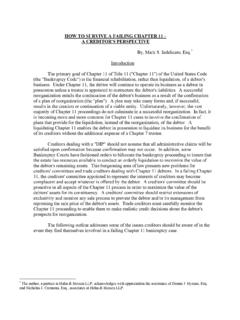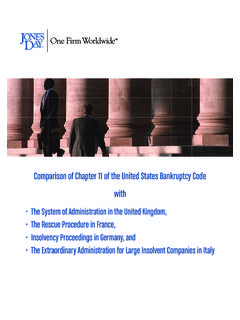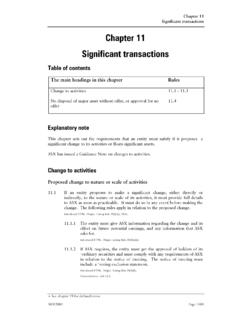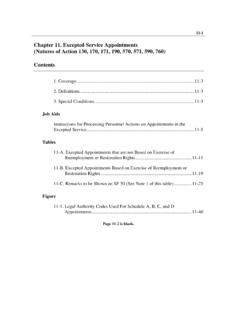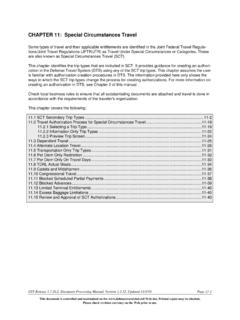Transcription of CHAPTER 11
1 CHAPTER 11 RADAR CROSS SECTIONE ugene F. KnottThe Boeing INTRODUCTIONA radar detects or tracks a target, and sometimes can identify it, only becausethere is an echo signal. It is therefore critical in the design and operation of radarsto be able to quantify or otherwise describe the echo, especially in terms of suchtarget characteristics as size, shape, and orientation. For that purpose the targetis ascribed an effective area called the radar cross section. It is the projected areaof a metal sphere which would return the same echo signal as the target had thesphere been substituted for the the echo of the sphere, however, which is independent of the viewingangle, the echoes of all but the simplest targets vary significantly with orienta-tion.
2 As such, one must mentally allow the size of this fictitious sphere to vary asthe aspect angle of the target changes. As will be shown, the variation can bequite rapid, especially for targets many wavelengths in echo characteristics depend in strong measure on the size and nature ofthe target surfaces exposed to the radar beam. The variation is small for electri-cally small targets (targets less than a wavelength in size) because the incidentwavelength is too long to resolve target details. On the other hand, the flat, singlycurved and doubly curved surfaces of electrically large targets each give rise todifferent echo characteristics.
3 Reentrant structures like jet engine intakes and ex-hausts generally have large echoes, and even the trailing edges of airfoils can besignificant echo sources. The characteristics of some common targets and targetfeatures are discussed in Sec. radar cross sections of simple bodies can be computed exactly by a solu-tion of the wave equation in a coordinate system for which a constant coordinatecoincides with the surface of the body. The exact solution requires that the elec-tric and magnetic fields just inside and just outside the surface satisfy certain con-ditions that depend on the electromagnetic properties of the material of which thebody is these solutions constitute interesting academic exercises and can, withsome study, reveal the nature of the scattering mechanisms that come into play,there are no known tactical targets that fit the solutions.
4 Thus, exact solutions ofthe wave equation are, at best, guidelines for gauging other (approximate) meth-ods of computing scattered alternative approach is the solution of the integral equations governing thedistribution of induced fields on target surfaces. The most useful approach at so-lution is known as the method of moments, in which the integral equations arereduced to a system of linear homogeneous equations. The attraction of themethod is that the surface profile of the body is unrestricted, allowing the com-putation of the scattering from truly tactical objects.
5 Another is that ordinarymethods of solution (matrix inversion and gaussian elimination, for example) maybe employed to effect a solution. The method is limited by computer memory andexecution time, however, to objects a few dozen wavelengths in size at to these exact solutions are several approximate methods thatmay be applied with reasonable accuracy to electrically large target include the theories of geometrical and physical optics, the geometrical andphysical theories of diffraction, and the method of equivalent currents. These ap-proximations are discussed in Sec.
6 Other approximate methods not dis-cussed here are explored in detail in some of the references listed at the end ofthis practical engineer cannot rely entirely on predictions and computationsand must eventually measure the echo characteristics of some targets. This maybe done by using full-scale test objects or scale models thereof. Small targets of-ten may be measured indoors, but large targets usually must be measured on anoutdoor test range. The characteristics of both kinds of test facilities are de-scribed in Sec. of the echo characteristics of some targets is of vital tactical impor-tance.
7 There are only two practical ways of doing so: shaping and radar absorb-ers. Shaping is the selection or design of surface profiles so that little or no en-ergy is reflected back toward the radar. Because target contours are difficult tochange once the target has become a production item, shaping is best imple-mented in the concept definition stage before production decisions have beenmade. Radar-absorbing materials actually soak up radar energy, also reducing theenergy reflected back to the radar. However, the application of such materialscan be expensive, whether gauged in terms of nonrecurring engineering costs,lifetime maintenance, or reduced mission capabilities.
8 The two methods of echocontrol are discussed in Sec. otherwise noted, the time convention used in this CHAPTER is exp(- uof), with the time dependence suppressed in all equations. Readers who pre-fer the exp (jut) time convention may replace i by -j wherever it THECONCEPTOFECHOPOWERD efinition of RCS. An object exposed to an electromagnetic wave dispersesincident energy in all directions. This spatial distribution of energy is calledscattering, and the object itself is often called a scatterer. The energy scatteredback to the source of the wave (called backscattering) constitutes the radarecho of the object.
9 The intensity of the echo is described explicitly by the radarcross section of the object, for which the abbreviation RCS has been generallyrecognized. Early papers on the subject called it the echo area or the effectivearea, terms still found occasionally in contemporary technical formal definition of radar cross section is\E I2a = Hm 4ir/?2 -^- ( )/?-+oc If0"2where E0 is the electric-field strength of the incident wave impinging on the targetand Ex is the electric-field strength of the scattered wave at the radar.
10 The deri-vation of the expression assumes that a target extracts power from an incidentwave and then radiates that power uniformly in all directions. Although the vastmajority of targets do not scatter energy uniformly in all directions, the definitionassumes that they do. This permits one to calculate the scattered power densityon the surface of a large sphere of radius R centered on the scattering object. R istypically taken to be the range from the radar to the symbol a has been widely accepted as the designation for the RCS of anobject, although this was not so at '2 The RCS is the projected area of ametal sphere which is large compared with the wavelength and which, if substi-tuted for the object, would scatter identically the same power back to the RCS of all but the simplest scatterers fluctuates greatly with the orientationof the object.


